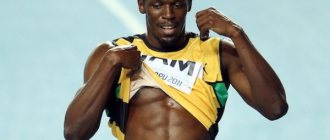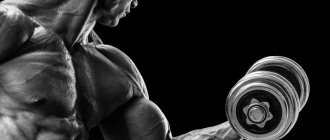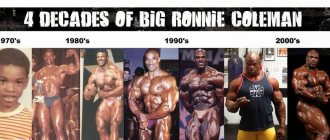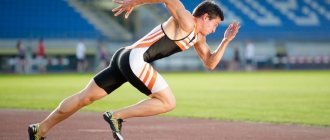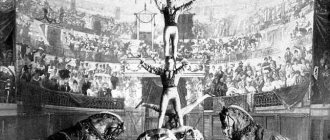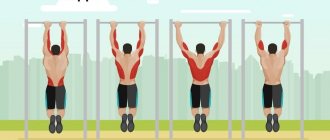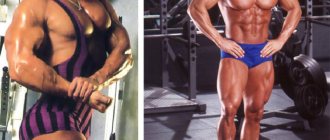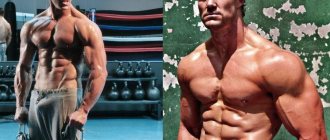The unique physical strength of some historical figures invariably excites the imagination of mankind. These amazing people are capable of making efforts that are inaccessible to an ordinary person.
Looking at one of them, Evgeniy Sandov, you begin to believe in the reality of the existence of mythical titans. How do these magnificent athletes differ from ordinary people? What powers and abilities allow them to perform miracles? What prompted them to such amazing self-improvement?
Let's lift the veil of secrecy using the example of life and transformation into a world star - an ordinary person.
Biography of Evgeniy Sandov
In the city of Königsberg on April 2, 1867, a weak, sickly boy was born into the family of Muller, a seller of greens and fruits. His name was Friedrich.
The parents were very worried about the health of the child, who differed from his peers in being unhealthy thin and weak. But constant illnesses and ailments did not break the boy’s surprisingly strong character. On the contrary, growing up and resenting his own weakness, Friedrich became interested in the study of anatomy and medicine and, while receiving an education, regularly worked on improving health and developing strength, based on his own practice and the knowledge gained in the learning process.
From a frail teenager, the young man gradually turns into a strong, self-confident athlete. So in Brussels, in 1887, Eugene Sandow (Eugene Sandow) appears - this is a stage name chosen after the surname of Friedrich’s Russian mother.
The athlete performs in the circus, demonstrating miracles of physical capabilities and defeating famous wrestlers in the ring.
After a stunning triumph in Europe, he goes to America, where he is completely immersed in developing his own system for developing the body's athletic capabilities.
At this stage, new talents of the master are discovered. Evgeniy reveals himself as a gifted businessman and organizer. He creates a prototype of a modern training room, advertising and offering specially designed training equipment to those interested.
Creates physical education institutes, simultaneously releasing brochures with the author’s methodology for developing strength. Organizes competitions in which athletes training according to his system participate.
After living in America for 4 years, he moved to England. Here, thanks to the fame he has gained, Sandov continues to successfully develop and popularize sports.
Based on his own experience, he publishes special literature:
- 1894 - “System of physical training.”
- 1904 - “Strength and how to become strong”
- 1912 - “Strength and Health.”
- 1919 - “Life is movement”
In 1911, King George V appointed him as his personal instructor. Sandow received the title of professor and published works on the treatment of diseases with the help of physical exercises. His book entitled “Bodybuilding” laid the foundation and gave the name to modern bodybuilding.
In 1925, the athlete’s car drove off the road and, after pulling it back with one hand, Evgeniy Sandov suffered a cerebral hemorrhage, from which he died.
How to exercise
How much of the day should you devote to exercise ? The answer to this question depends on the student himself - on his leisure time and his inclinations. Some find early morning the best and most convenient time, others prefer to exercise during the day, and finally, others find that they feel better and have more leisure in the evening. That's why I don't set a strictly defined time. The golden rule is to choose the part of the day that is most convenient for you, always avoiding exercising immediately after eating. If possible, do not start exercising until two hours after eating. Also, don't exercise right before bed if you find it makes you sleepy. Many of my students find that they sleep much better after exercise, but for others it has the opposite effect.
But if all hours are equally convenient for the student, then the best time for training according to my system is early in the morning. Stripped to the waist, in the privacy of his room, the student will find that it is possible to do the entire group of exercises in the space of 20 to 30 minutes.
It is advisable to practice in front of a mirror. In this way, one can follow the movements of different muscles, and seeing their work and observing their constant uniform development is in itself both help and pleasure.
If a student is weak on his legs, no matter how weak, he can do the exercises by slightly bending his knees. Or he can bend them one day and stand straight the next. If possible, then of course it is better to stand upright and in any case he should be able to do so before the end of the course.
What I would like to instill in students with poor health is that it is desirable to gradually achieve success. Many, before starting my system of physical training, were so weak that doctors had little hope of saving their lives. Now, however, they are among the most powerful. They developed themselves gradually, being careful not to undertake too much and thus adapting the exercises to their personal requirements. It should also be noted that for old people, no less than for young people, my system can be very useful, although people over fifty years of age should, in moderation, adhere to the tables for students aged from fifteen to seventeen years. My exercises can also bring significant benefits to people suffering from obesity.
Students should not be discouraged if they feel tired after the first days of training. Sometimes it happens that a young man or woman, or perhaps a middle-aged person, begins a course of training with the greatest enthusiasm. After two or three days the enthusiasm cools. Then a period of fatigue sets in, and the student begins to think that he should not continue the exercises. To such a student I would say very convincingly: “Do not give in to apparent difficulties; if you want success, then go forward; never give up." This fatigue also becomes a very pleasant feeling. You will soon like her; Personally, I can say that it is one of the most pleasant sensations I have ever experienced.
How long does it take to become strong ? The answer again depends on them - not only on their physical build, but also on the degree of participation of their will in the exercises. Muscles are developed by the brain, which can do as much or more than dumbbells. For example, when you sit reading, practice contracting your muscles. Do this every time you sit around and contracting them more and more each time, you will find that it will have the same effect as using dumbbells, or other more vigorous exercise.
For the beginner, the most difficult aspect of my system is to concentrate the thought so strongly on his muscles that he gains absolute control over them. The student will find, however, that this control will gradually appear to him. The brain sends an order to the muscles, the nerves receive it and transmit it to the latter. Regarding the willpower used in this case, it should be remembered that while the result of lifting weights is the contraction of muscles, the same result is obtained by simply contracting muscles, without lifting weights.
The reader will notice that in my exercises I insist on alternating movements. In this way, one arm or, depending on the exercise, one group of muscles, rests for a moment while the other moves. In this way, freer blood circulation is also obtained than with simultaneous use of movements.
Is it good if a student sweats after exercise ? To this I will say that it depends on the student’s body. If you sweat, then it benefits you, but if not, then it shows that your body is already fine. It goes without saying that my answer to this question, like others, concerns ordinary individuals. There will always be exceptions.
What is the overall benefit of the physical development system ? Its benefits, of course, are not limited to visible muscular development. Internal organs also participate in it. The liver and kidneys are kept in order, the heart and nerves are strengthened, the brain and energy are tightened. In a word, the body, like a child, needs education and such education can only be given through a series of exercises. With the help of the system the whole body develops, and students who follow my system confirm that not only their muscular strength has increased, but that their general health is satisfactory. In short, they feel as strong as they look.
Sandow's strength indicators
For his contemporaries, the master was an unattainable ideal. His records were not broken for a long time, and when this happened, subsequently, his opponents had more powerful physical abilities.
Society admired the magnificence of the athlete’s well-developed muscles, and ladies lined up to touch Sandow’s steel muscles for money:
Could lift a barbell weighing 122 kg with one hand.
Did up to 200 push-ups in 4 minutes.
He held 27kg weights on his arms outstretched forward for several seconds.
Holding a 24-kilogram weight in each hand, he stood on a handkerchief, then jumped and did a backflip, landing exactly there.
Leaning his heels on one chair and the back of his head on another, he held two people on his chest and a 22-kilogram weight in his outstretched hand.
Exercise tables by age
From the following tables, students of all ages can see how many times they should do each exercise daily. Before the age of seven, of course, you should not try to do these exercises. Starting from this age, daily exercises should be in accordance with the tables. To make it easier for everyone to understand the exercises, the anatomical table shows only the main muscles that act in each of them.
Students should be careful not to overexert themselves and, most importantly, not to exercise too vigorously.
Maintain tact in your movements, and it will be convenient to give each hand (not both hands) one second to move. Thus, for example, it will take 20 seconds to perform 10 movements with each arm in the first exercise. This pace is quite sufficient. Faster movements are not recommended for either young or old, and do not make movements abruptly, but exercise with ease and grace. TABLE I.
FOR CHILDREN OF BOTH SEXES, AGES SEVEN TO TEN YEARS (Use one pound dumbbells only).
| Exercise No. (see anatomical table) | Number of movements for each hand. | Increasing the number of movements (for No. 1 no more than 120) (the rest are proportional) |
| 1 2 3 4 5 6 7 Nos. 8,9 and 10 11 12 13 14 15 Nos. 16 and 17 17 18 | 10 5 5 4 4 10 6 — 5 5 2 5 3 no advice 10 10 | one every three days the same one every five days the same one every three days one every five days for aunts not recommended one every five days the same one every two weeks one every three days one every two weeks no advice one every three days the same |
TABLE II.
FOR CHILDREN OF BOTH SEXES, AGES TEN TO Twelve (use two pound dumbbells only).
| Exercise no. 1 2 3 4 5 6 7 No. 8,9 and 10 11 12 13 14 15 16 (only for boys) 17 18 | Number of movements 10 5 5 4 4 10 6 — 5 5 2 6 3 3 10 10 | Increasing the number of movements one every three days the same one every five days the same one every three days one every five days not recommended one every five days the same one every two weeks one every three days one every two weeks one every two weeks one every three days the same |
TABLE III.
FOR CHILDREN OF BOTH SEXES, AGES Twelve to Fifteen Years (Use three pound dumbbells only).
| Exercise no. 1 2 3 4 5 6 7 No. 8,9 and 10 11 12 13 14 15 16 (only for boys) 17 18 | Number of movements 10 5 5 4 4 10 6 — 5 5 2 6 3 3 15 10 | Increasing the number of movements one every three days the same one every five days the same one every three days one every five days not recommended one every five days the same one every two weeks one every three one day every two weeks the same one every three days the same |
TABLE IV.
FOR GIRLS, ages fifteen to seventeen (use three pound dumbbells only).
| Exercise no. 1 2 3 4 5 6 7 No. 8,9 and 10 11 12 13 14 15 16 17 18 | Number of movements 15 8 6 6 4 10 8 — 5 5 2 8 3 — 15 15 | Increasing the number of movements one every three days the same one every five days the same one every three days one every five days not recommended one every five days the same one every two weeks one every three one day every two weeks not recommended one every two weeks one every three days |
TABLE V.
FOR BOYS, ages fifteen to seventeen (use four pound dumbbells only). At this age, boys who have increased the number of movements of the first exercise from 30 to 120, and others in proportion to this, are advised to take the course again, but this time with 6-pound dumbbells.
| Exercise no. 1 2 3 4 5 6 7 No. 8,9 and 10 11 12 13 14 15 16 17 18 | Number of movements 30 15 10 8 5 12 8 — 5 5 2 15 3 3 25 25 | Increasing the number of movements one every other day one every two days the same one every three days one every two days one every three days not recommended one every two days the same one every week one every other day one every three days one every two weeks one every three days the same |
TABLE VI.
FOR GIRLS, ages seventeen and older (use four pound dumbbells only)
| Exercise no. 1 2 3 4 5 6 7 8,9,10 11 12 13 14 15 16 17 18 | Number of movements 20 10 7 7 4 10 8 — 5 5 2 10 3 — 20 20 | Increasing the number of movements one every other day one every two days the same one every three days one every two days one every three days until fatigue sets in one every two days the same one every week one every three days the same is not recommended one every three days the same |
TABLE VII.
FOR YOUTHS, aged seventeen years and older (use five pound dumbbells first) As stated in the note to Table
V
, students who have increased the number of movements of the first exercise from 30 to 120 and other exercises in proportion, are advised to work at this rate for six months and then increase the weight of the dumbbells by two pounds each and begin again according to Table
VII
, and then add two pounds every six months thereafter. At the end of the eighth course, with twenty pound dumbbells, I guarantee that the student, if he has worked diligently and continuously, will be as muscular as myself.
| Exercise no. 1 2 3 4 5 6 7 8,9,10 11 12 13 14 15 16 17 18 | Number of movements 50 25 10 10 5 15 10 — 10 10 3 25 3 3 25 25 | Increasing the number of movements five every day two every day one every day one every three days one every two days the same the same until fatigue sets in one every two days the same one every three days two every day one every two days the same two every day the same |
PS The maximum values turned out to be the following (last table):
| 1 2 3 4 5 6 7 8,9,10 11 12 13 14 15 16 17 18 | 50 25 10 10 5 15 10 — 10 10 3 25 3 3 25 25 | 55 27 11 10 5 15 10 — 10 10 3 27 3 3 27 27 | 60 29 12 10 6 16 11 — 11 11 3 29 4 4 29 29 | 65 31 13 11 6 16 11 — 11 11 4 31 4 4 31 31 | 70 33 14 11 7 17 12 — 12 12 4 33 5 5 33 33 | 75 35 15 11 7 17 12 — 12 12 4 35 5 5 35 35 | 80 37 16 12 8 18 13 — 13 13 5 37 6 6 37 37 | 85 39 17 12 8 18 13 — 13 13 5 39 6 6 39 39 | 90 41 18 12 9 19 14 — 14 14 5 41 7 7 41 41 | 95 43 19 13 9 19 14 — 14 14 6 43 7 7 43 43 | 100 45 20 13 10 20 15 — 15 15 6 45 8 8 45 45 | 105 47 21 13 10 20 15 — 15 15 6 47 8 8 47 47 | 110 49 22 14 11 21 16 — 16 16 7 49 9 9 49 49 | 115 51 23 14 11 21 16 — 16 16 7 51 9 9 51 51 | 120 53 24 14 12 22 17 — 17 17 7 53 10 10 53 53 |
Power numbers of Evgeniy Sandov
- His most amazing performance was fighting a lion. The animal was given a muzzle and special bags on its paws so that the predator could not use its claws. The lion rushed at the artist, and he caught him, held him and threw him aside.
- A platform was installed on the athlete’s chest on which stood three horses or an eight-person orchestra with a piano.
- Standing on a handkerchief, he held 27 kg in each hand and did somersaults with them, landing on the same handkerchief.
- Hanging in the air between two chairs, with support on the back of his head and heels, he could hold two people on his own body, like on a bridge, while holding 22 kg in each on his outstretched arms.
- He lifted and pressed a barbell weighing 115 kg, transferred it to the other hand, did a squat, lay on his back, holding the apparatus at arm's length above his head, then easily rose to his feet.
The percentage of body fat in women and the method for calculating it
In women, fat is deposited more unevenly in the body than in men, and therefore it is necessary to use not only different sites for measuring skin folds and anthropometric measurements, but also a larger number of them. This makes the procedure for calculating the desired percentage somewhat more complicated. Here is the best method known to me, which has advantages over others also because it does not require the use of calipers.
Body weight without fat, in kg = 8.987 + 0.732 (weight in kg) +
+ 3.786 (wrist diameter, cm) —
— 0.157 (abdominal circumference, cm) —
— 0.249 (hip circumference, cm) +
+ 0.434 (forearm circumference, cm).
Then calculate your fat percentage as follows:
1. Convert your lean body weight to pounds by multiplying kilograms by 2.2046 (or keep it in kilograms if you've mastered the metric system).
2. Body fat percentage = body weight - body weight without fat / body weight.
As in the case of calculating this percentage for men, the standard error is about plus or minus 4%, and if the woman using this equation has more developed muscle mass than is usually the case in women, then all 4% should be subtracted from the result. result.
Sandow's recommendations for physical exercise
- Positive attitude and conscious exercise.
- Perform exercises until muscle pain appears.
- At the beginning of classes, the weight of dumbbells should not be large: for children over 7 years old and women - 1 - 2 kg, for adult men - from 2 kg.
- Exercise with light dumbbells for 30 minutes a day continuously or split into two 15-minute sessions.
- Start exercising no earlier than 2 hours after eating.
- Individual choice of time of day for classes.
- For better control of the exercise technique, practice in front of a mirror.
- Gradually increase weight and number of repetitions.
- Do not engage children under 7 years of age.
- Avoid sudden movements and overexertion during exercise.
- Alternation of movements in the exercise.
- Water procedures and dry rubbing at the end of the lesson.
For men and women Determination of body fat percentage
To date, there are no methods for determining body fat that are suitable for individuals with strong muscle development. All existing methods are designed (with the exception of hydrostatic weighing) for certain groups of the population (for example, boys and girls, older men and women athletes in general, students of both sexes, etc.). Therefore, the best that can be hoped for (excluding, of course, possible access to underwater weighing with all the necessary equipment and technical personnel) will be more or less accurate interpolation.
Over the past few years, I have hydrostatically weighed quite a number of eventers and have found that simpler methods of determining the desired percentage using skin folds and anthropometric measurements are quite inaccurate (compared to the very accurate hydrostatic method). On average, these simpler methods make an error of 3-4%, overestimating the actual percentage of fat tissue in the body. So, for example, if using the skinfold technique the percentage of fat is determined to be 18%, then the actual percentage of fatty tissue in the body of a given triathlete is approximately 14-15%.
Thus, male and female eventers will likely need to subtract a small number from the data they obtain using the techniques described below. It should be remembered, however, that such a subtraction is more appropriate when measurements are made in relation to individuals with highly developed muscles, such a subtraction may be very insignificant (if it makes sense at all) when it comes to beginner triathletes.
Exercises that make up the Sandow system
| Biceps. Back straight, standing, arms along the body with dumbbells, palms forward. Without moving your elbows, bend your arms at the elbow joint towards your shoulders one by one. |
| Forearm extensors and biceps. The same as in exercise 1, but the palms are turned back, the hands hold the dumbbells with an overhand grip. |
| Biceps, deltoids, triceps. Standing, back straight, arms to the sides, body forming the letter T, palms up. We bend our arms at the elbows one by one, without lowering them. |
| Same as in exercise 3, but we bend our arms at the same time. Bend as you inhale, extend as you exhale. |
| Muscles of the chest, back, shoulder girdle. Standing, arms with dumbbells extended forward at shoulder level, palms facing each other. We spread our arms to the sides while inhaling, back to the i.p. on the exhale. |
| Deltoid, trapezius and triceps muscles of the shoulders. Standing, back straight, looking forward, hands with dumbbells at the shoulders, palms facing each other. Raise your arms horizontally up one at a time. |
| Deltoid muscles. Back slightly bent, hands on hips, overhand grip, palms down. Raise your arms one at a time to shoulder level. |
| Strengthening the wrist joints and forearm muscles. Palms down, arms with dumbbells to the sides. We turn the projectiles with our hands: up - down, forward - back. |
| Same as ex. 8, but we take the dumbbells by one end and rotate the hands forward and backward. |
| We strengthen the muscles of the thigh, back and abs. Stand with your back and legs straight. Hands with dumbbells above your head vertically, palms facing each other. Without bending your knees, bend over, hands touch the floor - exhale. We return to IP. - inhale. |
| Leg and deltoid muscles. Standing, back straight, arms with dumbbells along the body. We bend our right arm so that the forearm is perpendicular to the body, lunge forward with our left leg, while simultaneously straightening our right arm horizontally - exhale. We quickly return to the IP position, moving the elbow back - inhale. Repeat for the left arm and right leg. |
| Deltoid and trapezius muscles. Standing, back straight, arms with dumbbells along the body. We raise both arms simultaneously through the sides up - inhale. We return to IP. - exhale. |
| Muscles of the chest, shoulder girdle, triceps. Push ups. The body from the back of the head to the heels forms a straight line, lying down. Bend your elbows, trying to touch your chest to the floor. We go down as we inhale, we rise as we exhale. |
| Obliques, biceps, deltoids, trapezius. Standing, back straight, arms with dumbbells along the body. As you inhale, bend to the left, while simultaneously raising your right arm so as to bring the dumbbell to your armpit. As you exhale, we return to IP. Repeat to tilt to the right. |
| Abdominal muscles. Lying on your back, the body forms a straight line, arms with dumbbells are extended above the head, continuing the line of the body. The legs are fixed motionless. We sit down with the strength of the abdominal press, without bending our arms, and bend over - hands to the feet as we exhale. We return to i. p. while inhaling. |
| Abdominals and quadriceps muscles. Lying on your back with your hands behind your head. Raise your straight legs to a position perpendicular to the floor as you exhale. We return to IP. while inhaling. |
| Calf and quadriceps muscles of the thigh. Standing straight, arms with dumbbells along the body. We perform a squat until an angle of 90 degrees is formed with the thigh and shin, while simultaneously lifting onto the toes - inhale. We return to IP. - exhale. |
| We strengthen the wrist joints and forearm muscles. Standing, arms with dumbbells along the body. We bend and straighten our hands at the wrist joints. |
The following videos show and explain in sufficient detail all the movements presented.
The secret of a cold bath
If the student can do the exercises in the morning, as soon as he gets out of bed, then I advise him, while the body is still hot from physical work, to take a cold bath. It doesn't matter how much he sweats; a cold bath will prove extremely beneficial. Of course, one should not, however, take baths if he has shortness of breath. Exercise, of course, speeds up the heart rate, but after 3-5 minutes the heart should beat normally again. I do not advise people suffering from a weak heart to take cold baths. Generally speaking, there is no need to think about the question: “Is my heart weak?” If it is weak, then you will undoubtedly have to know it, because, paradoxically as it may seem, but after the slightest effort you will feel how it beats in your head.
In advising cold baths, I am, of course, addressing people who enjoy ordinary health. Bathing should begin in the summer and continue all year round, day after day, in the morning. In winter, if the room is cold, you should heat and close the door (to avoid drafts). If cold water is not harmful to your hair - and in many cases, in my opinion, it even strengthens it - start by standing over the bathtub and pumping your head 25 times. Then, still standing over the bathtub, splash water 15 times into your chest and 10 times against your heart. Then sit in the bath, immersing yourself headlong. In summer you can stay in the water for 10 to 15 seconds, but in winter you just need to jump into the water and get out immediately.
It is customary to prescribe a good half of the benefits brought by cold baths to subsequent vigorous rubbing with a towel. I don't hesitate to call it a big mistake, and here's why. When you get out of the bath, you wipe first one part of the body, and then the other, and thus, while one part heats up from friction, the other cools down. Many who bathe in this way complain of mild attacks of rheumatism - in my opinion, all this happens because different parts of the body are alternately warmed and cooled.
To avoid this danger, I advise you not to waste time on all-round vigorous rubbing. If you don’t like dressing wet, then remove the water with a dry towel as soon as possible, get dressed as soon as possible and let nature restore blood circulation in its own way. In this way, you will warm up just as well as vigorous rubbing, with the added advantage that the heat will be more evenly distributed throughout the body. If, due to ill health or other exceptional reasons, proper blood circulation is not restored immediately and completely, then briskly walk back and forth around the room. If after this, any part of the body is still cold, then swimming is probably not suitable for your body and in this case is not recommended. But in 99 cases out of a hundred, a cold bath taken according to my prescription will have only beneficial consequences, and taken every morning throughout the year, is the surest preventative against colds known to me. Irregularity, on the other hand, contributes to colds. In short, once you start cold baths, you should make it a rule to never stop them, neither in summer nor in winter.
Personally, I find that the best thing is to get dressed without drying yourself at all. At first, the feeling may not be entirely pleasant, but then, if you stick to this method, you will feel better and warmer. The dampness evaporates through the clothes and not a single drop of moisture remains.
For students who do not have a bathroom at their disposal, we can advise that instead of a bath - wiping with cold water; in this case, you should soak two towels well in water. Wipe the front of the body with one, and the back with the other. This technique will not allow the towel to absorb body heat, and the cold rubdown will thus be evenly distributed over its surface. Then, as said, you should dry yourself quickly and get dressed without wasting time.
Basic principles of training
1. You need to devote as much free time as possible to training.
2. Physical exercises must be properly designed.
3. When choosing the weight of the projectiles, you should take into account age and initial physical data.
4. A prerequisite for performing the exercises is to perform them in front of a mirror. This will allow you to achieve the most correct execution technique.
5. Perform movements at a calm pace. 2 seconds to complete each contraction.
6. Every 30 days of regular training, you should add weight to the dumbbells.
7. An integral part of the system are static exercises. Their strength grows quickly.
8. Do not start exercising immediately after eating.
9. After finishing the exercises, you should take a bath filled with cool water or at least wipe yourself with a damp towel, after which you should immediately dry off.
Evgeniy Sandov: exercises with dumbbells
The father of modern bodybuilding introduced gymnastics with apparatus 125 years ago. The author of the method assures that 2 dumbbells from 2-9 kg can make every person. To confirm this, he presented a program with isolation exercises and multiple repetitions. Beginning bodybuilders today use this system to hone their definition.
The method is based on a gradual increase in weight by 1 kg every six months and increasing repetitions by 3 after 6 workouts. At the start, the beginner performs 12-16 doubles for the upper body and 10 for the lower part in one set. The complex includes 18 techniques:
- biceps curls with different grips;
- bending limbs from different positions;
- alternate presses and lifts of dumbbells;
- circular rotation of projectiles with brushes;
- bending to the floor;
- push ups;
- leg lifts and others.
The strongman assures that if you go through all the stages, the muscles will be the same as his. This statement caused a lot of controversy. Experts say that with this scheme it is permissible to slightly pump up the muscles and define the relief, but you should not count on a significant increase in mass and development of strength. In his books, Evgeniy Sandov writes about training with jerks from the floor, bench presses with heavy weights, and squats with a heavy barbell. It was they who developed such power in him and formed an athletic figure, but for unknown reasons the author did not include them in dumbbell training. The conclusion is simple: the system allows you to tighten your figure, but for mass and explosive strength it is better to choose a strength program with heavy weights.

